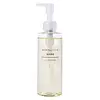What's inside
What's inside
 Key Ingredients
Key Ingredients

 Benefits
Benefits

 Concerns
Concerns

 Ingredients Side-by-side
Ingredients Side-by-side

Hydrogenated Polyisobutene
EmollientCoconut Oil Polyglyceryl-6 Esters
EmollientEthyl Oleate
EmollientSorbitan Oleate
EmulsifyingOlea Europaea Fruit Oil
MaskingSimmondsia Chinensis Seed Oil
EmollientHelianthus Annuus Seed Oil
EmollientDipropylene Glycol
HumectantCitrus Aurantium Amara Flower Water
MaskingPolyquaternium-51
Skin ConditioningPrunus Persica Leaf Extract
EmollientMalt Juice
Skin ConditioningSodium Hyaluronate
HumectantGlycerin
HumectantButylene Glycol
HumectantTocopherol
AntioxidantPhenoxyethanol
PreservativeMethylparaben
PreservativeHydrogenated Polyisobutene, Coconut Oil Polyglyceryl-6 Esters, Ethyl Oleate, Sorbitan Oleate, Olea Europaea Fruit Oil, Simmondsia Chinensis Seed Oil, Helianthus Annuus Seed Oil, Dipropylene Glycol, Citrus Aurantium Amara Flower Water, Polyquaternium-51, Prunus Persica Leaf Extract, Malt Juice, Sodium Hyaluronate, Glycerin, Butylene Glycol, Tocopherol, Phenoxyethanol, Methylparaben
Glycine Soja Oil
EmollientCorylus Avellana Seed Oil
EmollientSorbeth-30 Tetraoleate
EmulsifyingVitis Vinifera Seed Oil
EmollientOlea Europaea Fruit Oil
MaskingCaprylic/Capric Triglyceride
MaskingSqualane
EmollientIsoamyl Laurate
EmollientCamellia Japonica Seed Oil
EmollientOenothera Biennis Oil
EmollientSimmondsia Chinensis Seed Oil
EmollientHelianthus Annuus Seed Oil
EmollientArgania Spinosa Kernel Oil
EmollientOrbignya Oleifera Seed Oil
EmollientSaponaria Officinalis Leaf Extract
AntimicrobialCamellia Sinensis Leaf Extract
AntimicrobialOryza Sativa Bran Oil
EmollientRice Ferment Filtrate
Skin ConditioningDecyl Glucoside
CleansingGinkgo Biloba Leaf Extract
Skin ConditioningLavandula Angustifolia Oil
MaskingAloe Barbadensis Leaf Extract
EmollientCitrus Aurantium Dulcis Oil
MaskingMelaleuca Alternifolia Leaf Oil
AntioxidantTocopherol
AntioxidantGlycine Soja Oil, Corylus Avellana Seed Oil, Sorbeth-30 Tetraoleate, Vitis Vinifera Seed Oil, Olea Europaea Fruit Oil, Caprylic/Capric Triglyceride, Squalane, Isoamyl Laurate, Camellia Japonica Seed Oil, Oenothera Biennis Oil, Simmondsia Chinensis Seed Oil, Helianthus Annuus Seed Oil, Argania Spinosa Kernel Oil, Orbignya Oleifera Seed Oil, Saponaria Officinalis Leaf Extract, Camellia Sinensis Leaf Extract, Oryza Sativa Bran Oil, Rice Ferment Filtrate, Decyl Glucoside, Ginkgo Biloba Leaf Extract, Lavandula Angustifolia Oil, Aloe Barbadensis Leaf Extract, Citrus Aurantium Dulcis Oil, Melaleuca Alternifolia Leaf Oil, Tocopherol
 Reviews
Reviews

Ingredients Explained
These ingredients are found in both products.
Ingredients higher up in an ingredient list are typically present in a larger amount.
Helianthus Annuus Seed Oil is the oil derived from the seeds of a Sunflower. Sunflower seed oil is non-fragrant. It is an emollient, meaning it helps to soften the skin.
Sunflower seed oil contains many fatty acids. The fatty acids found in sunflower seeds include (from highest amount to least): linoleic acid, myristic acid, palmitic acid, stearic acid, arachidic acid, oleic acid, and linolenic acid.
These fatty acids help the skin create ceramides. Ceramides play a role in repairing the skin barrier.
Helianthus Annuus Seed Oil helps moisturize the skin. This in turn helps the skin look more rejuvenated and smoother.
Sunflowers are rich in vitamin E.
Historians believe Indigenous cultures of North America domesticated sunflowers before corn. Thus they relied on sunflower oil for a variety of uses. One such use is moisturizing skin and hair.
Sunflower seed oil may not be fungal acne safe. We recommend speaking with a professional if you have any concerns.
Learn more about Helianthus Annuus Seed OilOlea Europaea Fruit Oil is the fixed oil obtained from the ripe fruit of the Olive. In other words - olive oil.
The primary contents of olive oil are glycerides of the fatty acids linoleic, oleic and palmitic.
Olive oil also contains antioxidants such as Vitamin E. Antioxidants may help reduce signs of aging by fighting unstable free-radical molecules. It also contains Vitamins A (retinol), D, and K.
The squalene in olive oil makes it a great emollient. Emollients help soothe and soften your skin by trapping moisture in. This makes olive oil a great skin moisturizer.
Studies show olive oil to have antibacterial and antifungal properties in low concentrations. Another study found olive oil irritated sensitive oily skin. We always recommend speaking with a professional about using this ingredient in your routine.
Due to the fatty acid content, this ingredient may not be fungal-acne safe.
Learn more about Olea Europaea Fruit OilThis oil comes from the seeds of the desert shrub called Jojoba. It is more commonly known as jojoba oil, a non-comedogenic oil.
Jojoba oil does not contain fragrance and has many fatty-acids, making it a great soothing ingredient.
It also contains Vitamin E, a great moisturizing ingredient. Vitamin E is also an antioxidant and protects your skin against oxidative damage.
This ingredient humectant properties, meaning it helps draw moisture from the air. This helps keep your skin hydrated.
While jojoba has antibacterial properties, it is only able to kill some strains of bacteria.
Studies also show it helps in wound healing. In fact, Indigenous cultures have used jojoba as a moisturizer and to help treat burns for centuries.
Fun fact: Jojoba oil similar to natural human skin sebum, so it has a great effect on dry skin. It is also promising with helping to regulate sebum production.
Due to its fatty acid content, Jojoba oil may not be fungal acne safe. We recommend speaking with a professional if you have any concerns.
Learn more about Simmondsia Chinensis Seed OilTocopherol (also known as Vitamin E) is a common antioxidant used to help protect the skin from free-radicals and strengthen the skin barrier. It's also fat soluble - this means our skin is great at absorbing it.
Vitamin E also helps keep your natural skin lipids healthy. Your lipid skin barrier naturally consists of lipids, ceramides, and fatty acids. Vitamin E offers extra protection for your skin’s lipid barrier, keeping your skin healthy and nourished.
Another benefit is a bit of UV protection. Vitamin E helps reduce the damage caused by UVB rays. (It should not replace your sunscreen). Combining it with Vitamin C can decrease sunburned cells and hyperpigmentation after UV exposure.
You might have noticed Vitamin E + C often paired together. This is because it is great at stabilizing Vitamin C. Using the two together helps increase the effectiveness of both ingredients.
There are often claims that Vitamin E can reduce/prevent scarring, but these claims haven't been confirmed by scientific research.
Learn more about Tocopherol